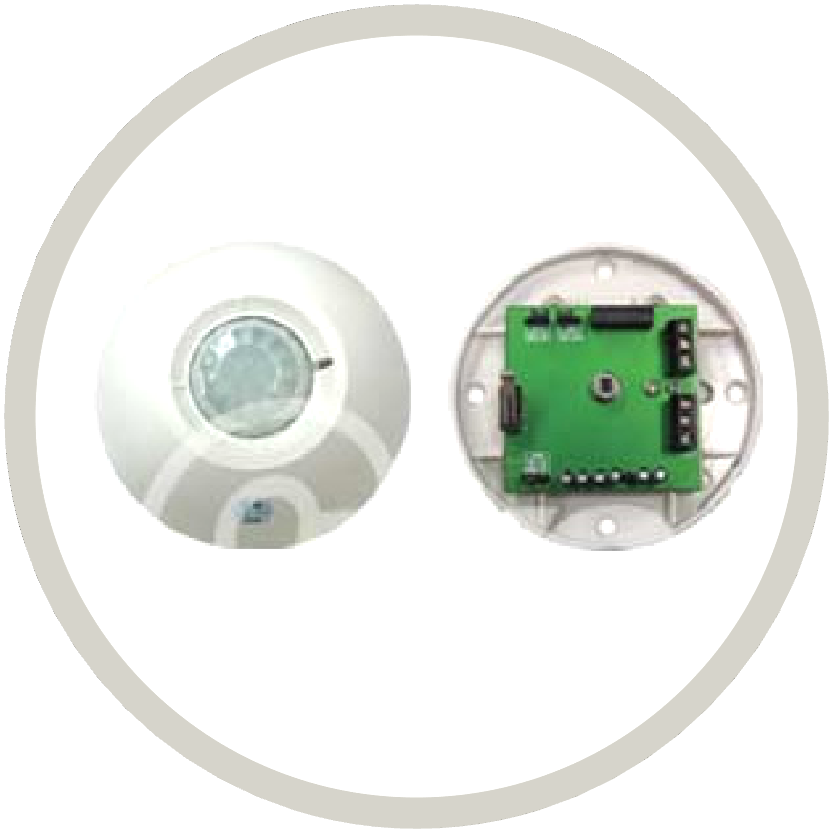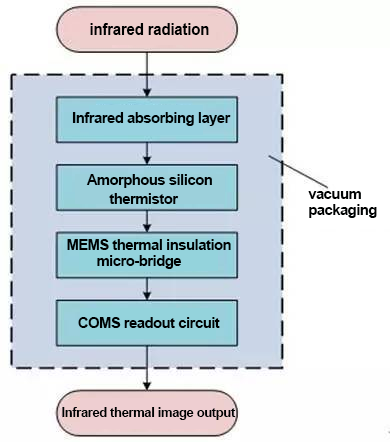
Überblick
Der Infrarot-Brennebenendetektor ist die Kernkomponente des Wärmebildsystems und der Schlüssel zur Erkennung, Identifizieren und Analysieren der Infrarotinformationen von Objekten. Es hat ein breites Anwendungsspektrum im Militär, Industrie, Transport, Sicherheitsüberwachung, Meteorologie, Medizin und anderen Bereichen.
Infrarot-Brennebenendetektoren können in gekühlte Infrarot-Brennebenendetektoren und ungekühlte Infrarot-Brennebenendetektoren unterteilt werden. Die Vorteile gekühlter Infrarot-Fokalebenendetektoren liegen in der hohen Empfindlichkeit, Fähigkeit, subtilere Temperaturunterschiede zu unterscheiden, und längere erkennung abstand. Es wird hauptsächlich in hochwertiger militärischer Ausrüstung verwendet. Der ungekühlte Infrarot-Fokalebenendetektor benötigt keine Kühlvorrichtung und kann bei Raumtemperatur betrieben werden. Es hat die Vorteile der geringen Größe, geringes Gewicht, geringer Stromverbrauch, langes Leben, niedrige Kosten, und schnelle Inbetriebnahme. Allerdings ist er nicht so empfindlich wie gekühlte Infrarot-Fokalebenendetektoren, Die Leistung ungekühlter Infrarot-Fokalebenendetektoren kann die technischen Anforderungen einiger militärischer Geräte und der meisten zivilen Bereiche erfüllen.
Funktionsprinzip

Der ungekühlte Infrarot-Fokalebenendetektor besteht aus vielen MEMS (Mikroelektromechanische Systeme) Mikrobrückenstruktur-Pixel, die zweidimensional wiederholt auf der Brennebene angeordnet sind, und jedes Pixel misst die Wärmestrahlung in einem bestimmten Einfallswinkel. Grundprinzip:
A): Infrarotstrahlung wird von der infrarotabsorbierenden Schicht im Pixel absorbiert und führt zu einer Temperaturänderung, Dadurch ändert sich der Widerstandswert des amorphen Silizium-Thermistors;
B): Der amorphe Silizium-Thermistor wird über dem Siliziumsubstrat durch eine MEMS-Mikrobrücke mit Wärmeisolierung getragen, und ist über eine Stützstruktur mit der auf dem Siliziumsubstrat gefertigten COMS-Ausleseschaltung verbunden;
C): Die CMOS-Schaltung wandelt die Widerstandswertänderung des Thermistors in einen Differenzstrom um und führt eine Integralverstärkung durch. Nach der Probenahme, Es wird der Grauwert eines einzelnen Pixels im Infrarot-Wärmebild ermittelt.
Schlüsselparameter, die die Leistung beeinflussen
1. Rücklaufquote:
Es bezieht sich auf das Verhältnis des Ausgangssignals zur eingegebenen Infrarotstrahlungsleistung. Je größer die Rücklaufquote, desto besser ist die Leistung des Detektors.
2. Antwortwellenlängenbereich:
Ungekühlt (hitzeempfindlich) Infrarotdetektoren haben keine Selektivität für die Reaktionswellenlänge, und zeigen die gleiche Empfindlichkeit gegenüber einfallendem Licht verschiedener Wellenlängen. Im Allgemeinen bei Raumtemperatur arbeiten, Die Empfindlichkeit ist gering, und die Reaktionszeit ist auch lang.
3. Lärm:
Rauschen entsteht durch einige grundlegende physikalische Prozesse im Infrarotdetektor, auch ohne einfallende Strahlung, es wird Lärm geben. Rauschen beeinträchtigt die Erkennungsgenauigkeit des Infrarotdetektors, desto kleiner ist der Lärm, desto besser ist die Leistung des Detektors.
Das Detektorrauschen umfasst hauptsächlich Dunkelstromrauschen und Photoelektronenrauschen. Die Hauptmethode zur Reduzierung des Dunkelstromrauschens besteht darin, die Temperatur von Raumtemperatur auf die Temperatur von flüssigem Stickstoff zu senken, und das Dunkelstromrauschen kann um reduziert werden 50%.
4. Signal-Rausch-Verhältnis(SNR):
Es bezeichnet das Verhältnis der durch die einfallende Strahlung erzeugten Signalausgangsspannung zur gleichzeitig ausgegebenen Rauschspannung. Je höher das Signal-Rausch-Verhältnis des Geräts ist, desto geringer ist der Lärm, und umgekehrt. daher, desto höher ist das Signal-Rausch-Verhältnis, desto besser.
5. Rauschäquivalente Leistung:
Wenn die durch die einfallende Strahlung erzeugte Ausgangsspannung genau der Rauschspannung des Detektors selbst entspricht, Die zu diesem Zeitpunkt einfallende Strahlungsleistung wird als Rauschäquivalentleistung bezeichnet. Je geringer die rauschäquivalente Leistung des Detektors ist, desto besser.
6. Lärmäquivalenter Temperaturunterschied:
Damit ist der minimale Temperaturunterschied gemeint, den der Infrarotdetektor erkennen kann, desto kleiner der Wert, desto besser.
7. Erkennungsrate:
Es ist der Kehrwert der rauschäquivalenten Temperaturdifferenz. Je höher die Erkennungsrate, desto besser.
Anwendung
Ungekühlte Infrarotdetektoren haben ein sehr breites Anwendungsspektrum im militärischen und kommerziellen Bereich:
1. Militärischer Bereich
Zu den Anwendungen im militärischen Bereich gehört das Thermal Weapon Sight (TWS), Tragbare Sehverbesserung, Verbesserung der Sicht des Fahrers (ZWEI), Fernwaffenstation (RWS), Unbemanntes Luftfahrzeug (UAV), Unbemannter Bodensensor(UGS), Beobachtungskommandofahrzeug, Raketenführung und -kontrolle, usw.
2. Wärmebild-Temperaturmessfeld
Zur vorausschauenden Wartung wird die Temperaturmessung per Wärmebildtechnik eingesetzt, Beispielsweise können mithilfe von Infrarot-Wärmekameras an Stromleitungen anormale Erwärmungsbereiche erkannt werden, Stromerzeugungsausrüstung, und mechanische Ausrüstung, Dadurch können größere Stillstände und Unfälle verhindert werden. Was die Bauinspektion angeht, Es dient zur Feststellung der Dämmwirkung von Häusern, Wandfassaden, Aushöhlung, Wassereinbruch und Schimmel, usw. Weitere Thermografieanwendungen umfassen die Produktentwicklung, Elektronikfertigung, medizinische Temperaturmessung und Prozesskontrolle, usw., wie in der Abbildung rechts gezeigt.
3. Kommerzieller Bereich zur Verbesserung der Sehkraft
Zu den Hauptanwendungen der kommerziellen Sehverbesserung gehört die Brandbekämpfung, Überwachung, Verbesserung der Infrarot-Sicht im Automobil- und maritimen Bereich, usw., wie in der linken Abbildung gezeigt. Es nutzt hauptsächlich die Vorteile der Infrarotbildgebung ohne externe Lichtquelle, starke Fähigkeit, Rauch zu durchdringen, große Reichweite, starker Bildkontrast, usw., um das menschliche Sehvermögen wirkungsvoll zu ergänzen.
4. Unterhaltungselektronik
Aufgrund der breiten Anwendung und extrem hohen Durchdringungsrate von Bildsensoren für sichtbares Licht in Produkten der Unterhaltungselektronik wie Mobiltelefonen, Menschen haben hohe Erwartungen an die Anwendung der Infrarotbildgebung in der Unterhaltungselektronik. Der großflächige Einsatz der Infrarot-Wärmebildtechnik in der Unterhaltungselektronik ist derzeit hauptsächlich durch Kosten und Volumen begrenzt. Derzeit, FLIR und Seek Thermal haben Wärmebildgeräte für Endverbraucher auf den Markt gebracht, was auch Vorfreude auf weitere Anwendungen von Infrarot-Wärmebildsensoren im Bereich der Unterhaltungselektronik weckt.
 Fronir: Optoelektronische Produkte
Fronir: Optoelektronische Produkte
